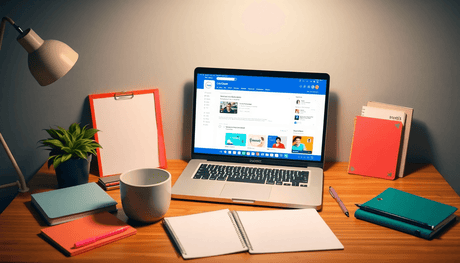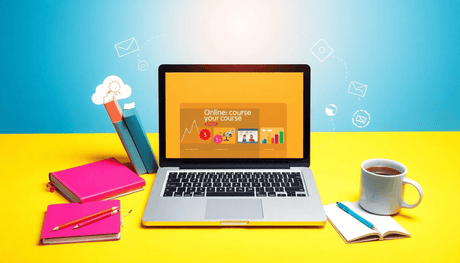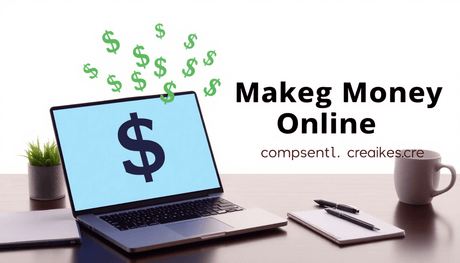A high-converting landing page is crucial for the success of your branded learning portal. It serves as the entry point to attract potential users and increase conversions. To make the most of your online course marketing efforts, it's important to understand the key principles behind creating an effective landing page.
In this article, we will explore these foundational concepts that will help you design a compelling and conversion-focused landing page.
1. Understanding Your Audience and Defining Clear Goals
Identifying your target audience is the foundation of a high-converting landing page for a branded learning portal. Most users fall into three primary categories:
- Entrepreneurs looking to expand their offerings with professional-grade PLR courses, like those available in our Uthena collection.
- Educators seeking customizable content for their students or training programs, which they can easily find on our platform.
- Content creators aiming to provide value-added resources under their own brand.
Each group has distinct motivations and pain points:
- Entrepreneurs want scalable products that require minimal setup.
- Educators prioritize quality and relevance for their curricula.
- Content creators focus on flexible branding and ease of customization.
Tailoring your messaging and design to these specific needs increases engagement and conversion rates. Use language that resonates with each segment’s goals and challenges. Highlight features such as ready-made courses from experts like Arbaz Khan, easy customization, and resell rights to demonstrate how your portal meets their demands.
Clear goal definition guides every design decision. Typical conversion goals include:
- Capturing leads through email sign-ups.
- Encouraging registrations for free trials or webinars.
- Driving direct course sales or subscription purchases.
Aligning your landing page elements—headlines, visuals, CTAs—with these focused objectives streamlines user experience and maximizes conversions. Precise goal setting prevents dilution of message and keeps visitors focused on taking action that benefits your learning portal business.
To further enhance the learning experience on your platform, consider applying as an instructor on our site by visiting our application page. This could not only improve the quality of content offered but also attract more educators seeking customizable resources for their students or training programs.
2. Crafting Compelling Headlines and Value Propositions
Your landing page needs compelling headlines that immediately grab attention and connect with your audience’s needs. Focus on clear, benefit-driven messaging that reflects the promises made in your ads or traffic sources. For example:
- "Launch Your Branded Learning Portal Today — No Tech Skills Needed"
- "Earn More with Professional PLR Courses Ready for Resale"
These headlines set expectations and motivate visitors to explore further.
Value statements must highlight what sets your portal apart. Emphasize how Uthena’s high-quality, customizable PLR courses empower entrepreneurs, educators, and content creators to build profitable learning businesses quickly. Use phrases like:
"Unlock fully brandable courses designed for immediate resale and customization."
A strong value proposition is essential in this context, as it clarifies how your portal solves problems — saving time, increasing revenue, or simplifying course creation. For instance, you could mention how Uthena's finance courses provide invaluable knowledge that can lead to better financial decisions or increased earnings. Similarly, hobby courses can help individuals turn their passions into profitable ventures, while design courses can empower creatives with the skills needed to succeed in their fields.
This alignment boosts relevance and encourages conversions by clearly communicating the unique advantages of your offering.
3. Designing a Clean and Professional Layout
A clean design plays a crucial role in Building a High-Converting Landing Page for Your Branded Learning Portal. Use whitespace strategically to separate sections and guide the visitor’s eye smoothly through the content. This technique reduces cognitive load, making it easier for users to digest information without feeling overwhelmed.
Focus on simplicity—limit the number of fonts, colors, and graphic elements to maintain a polished appearance. Avoid clutter by presenting only essential information that supports your key message and conversion goals. Minimal distractions help visitors stay focused on your offers, increasing the chances they engage with your CTAs.
Prioritize consistency in alignment and spacing to create a balanced layout. A professional look builds credibility and trust, signaling that your branded learning portal is reliable and worth exploring. Clean design enhances user experience, encouraging longer visits and higher conversion rates on your landing page.
4. Using Strong Visuals to Make Your Learning Portal More Appealing
Visual content is essential for grabbing attention and showcasing the quality of your branded learning portal. Here are some ways to use visuals effectively:
1. Include Explainer Videos
Add explainer videos that clearly demonstrate course features, benefits, and how learners engage with the material. Videos offer dynamic insight into the educational experience, making abstract benefits concrete.
2. Feature Instructor Photos
Use instructor photos to add a personal touch and build trust. Seeing real educators behind the courses humanizes your portal and reassures visitors about expertise and professionalism. For instance, Lambros Lazopoulos, a medical student and self-taught filmmaker, has created engaging content that showcases his unique teaching style.
3. Show High-Resolution Screenshots
Include high-resolution screenshots of course interfaces or modules. These images provide transparency, showing exactly what users can expect from your PLR courses on Uthena.
4. Display Testimonial Visuals
Testimonial visuals such as star ratings or customer photos paired with quotes create social proof that complements written reviews. They visually emphasize satisfaction and credibility without overwhelming the page.
5. Use Strong Visuals to Support Your Messaging
Strong visuals support your messaging by breaking up text and maintaining visitor interest while reinforcing key value points about your learning portal’s offerings. For instance, if you're interested in mastering Linux or CyberSecurity, courses taught by Ramsai Dupati could be beneficial. Additionally, if you're looking to enhance your marketing skills, Uthena offers a variety of marketing courses that could suit your needs.
5. Developing Persuasive Calls-to-Action (CTAs)
The effectiveness of your landing page hinges significantly on well-designed call-to-action buttons. These buttons should use contrasting colors that stand out from the rest of the design, instantly drawing the visitor's eye. Positioning CTAs above the fold ensures they are visible immediately when someone lands on your page, eliminating any guesswork about what action to take next.
Use action-oriented language that motivates visitors to engage. Phrases like “Get Started Now,” “Access Your Course,” or “Claim Your PLR License” communicate clear benefits and urgency without being pushy.
Incorporate multiple CTAs throughout your landing page, all directing toward the same conversion goal—whether it’s signing up, purchasing, or downloading content. This repetition reinforces the desired action without overwhelming or confusing the visitor.
Strong CTA placement combined with compelling copy creates a seamless path from interest to conversion, critical for maximizing the impact of your branded learning portal.
6. Simplifying Sign-Up with Short Relevant Forms
Optimizing your forms is crucial for reducing friction on your landing page and improving lead capture rates. When creating a landing page for your branded learning portal, it's important to keep sign-up forms as short as possible.
Collect Only the Essentials
Focus on gathering only the necessary information:
- Name
- Email address
Each additional field can create hesitation and lower completion rates. Visitors often abandon long forms because they don't have enough time or are concerned about their privacy. By limiting the number of fields in your form, you can create a smoother user experience that encourages people to take action quickly. This is a key aspect of form design best practices.
Use Clear Labels and Avoid Unnecessary Details
Make sure to use clear labels and intuitive input formats so that visitors don't get confused. Unless it's absolutely critical for your goals, avoid asking for unnecessary information such as phone numbers or company size. This aligns with avoiding common form building mistakes, which can deter potential users. Keeping your forms short and relevant will increase conversions by removing obstacles and making it easy for entrepreneurs, educators, and content creators to join your platform.
Focus on the Value of Your Courses
By keeping the sign-up process simple, you ensure that potential users can focus on the value of your branded courses instead of getting overwhelmed by complicated registration steps. Implementing strategies to improve user experience with web form design can further enhance this process.
7. Building Trust with Social Proof and Security Elements
Trust is a critical factor in converting visitors on your branded learning portal's landing page. Incorporate social proof testimonials from entrepreneurs, educators, and content creators who have successfully used Uthena’s PLR courses. Authentic reviews build credibility by showing real-life results and satisfaction.
Display industry affiliations or awards prominently to highlight your portal’s authority and professionalism. Badges from recognized organizations or certifications reassure visitors about the quality and legitimacy of your offerings.
If your landing page involves payments, add security labels such as SSL certificates or trusted payment gateway badges. These elements reduce anxiety around transactions, signaling that user data is protected.
Key trust-building elements to include:
- Verified testimonials showcasing positive outcomes
- Logos of industry partners or award recognitions
- Security badges near payment options for reassurance
Incorporating these features strengthens visitor confidence, making them more likely to engage and convert on your landing page.
8. Ensuring Mobile Responsiveness and Fast Load Times
In today's digital age, mobile optimization is no longer an option but a necessity. With the increasing use of smartphones and tablets for browsing, it's crucial to ensure that your landing page is fully optimized for mobile devices. This not only enhances the user experience but also has significant SEO benefits.
Optimizing for All Devices
Ensure your landing page functions seamlessly on smartphones and tablets to provide a positive user experience across different devices.
Enhanced Search Rankings
By having a responsive design that adapts to various screen sizes, you improve your site's visibility and ranking on search engine results pages.
Page Speed Importance
Fast load times are crucial for mobile users; optimizing images, reducing server response time, and leveraging browser caching can significantly enhance page speed.
SEO Benefits
Google prioritizes mobile-friendly websites in search results, making mobile optimization essential for organic traffic growth and overall visibility.
9. SEO Optimization for Organic Traffic Growth
To drive organic traffic growth, it's important to follow effective [SEO best practices](https://uthena.com/collections/alex-genadinik). This includes strategies like using keywords in headlines and image alt texts, which are especially relevant for PLR courses and branded portals.
Another important aspect is creating optimized meta descriptions that can greatly improve search visibility. These meta descriptions should be enticing and also include relevant keywords related to the courses offered, such as those from popular instructors like Jerry Banfield and Laurence Svekis, in order to attract more potential learners.
Furthermore, when designing a landing page for your branded learning portal that converts well, it's crucial to effectively implement these SEO strategies.
10. Using Urgency and Scarcity Tactics to Increase Conversions
Urgency tactics and scarcity marketing are powerful tools that can drive visitors to take immediate action on your branded learning portal. By emphasizing limited-time offers or enrollment deadlines for resell rights courses from Uthena, you provide users with a compelling reason to act quickly. These strategies leverage the fear of missing out (FOMO), which is a significant motivator in online purchasing behavior.
Effective Techniques for Creating Urgency and Scarcity
Here are some examples of effective urgency and scarcity techniques you can use:
- Display countdown timers indicating how much time is left for an exclusive PLR course offer
- Use limited quantity notices such as "Only 10 licenses left" for popular courses
- Implement early bird pricing that increases after a specific date
Reinforcing Action with Strategic Placement
You can strategically place these indicators near calls-to-action to reinforce why visitors should sign up or buy now instead of later. The combination of scarcity's psychological impact and clear messaging about the value of your customizable, high-quality Uthena courses will encourage faster decision-making and result in higher conversion rates.
Enhancing Value with Exclusive Collections
In addition, offering exclusive collections such as those from Dr. Elisaveta Pavlova for wellness insights or specialized AI courses can further enhance the perceived value and urgency, leading to increased conversions.
11. Utilizing Data through A/B Testing and Analytics
Data-driven decisions are essential for maximizing your landing page’s performance. A/B testing tools like Google Optimize or Unbounce enable you to experiment with different elements—headlines, calls-to-action (CTAs), and layouts—to identify what resonates best with your audience. Testing variations helps pinpoint the most effective messaging and design that drive conversions.
Focus on tracking key metrics such as:
- Bounce rates — measure how many visitors leave without interacting
- Submission rates — track form completions or sign-ups
Analyzing these behaviors provides insight into visitor engagement and barriers to conversion. For example, if a certain headline leads to higher submission rates, it’s a clear winner. If a layout causes visitors to bounce quickly, adjustments are necessary.
Use visitor behavior analysis to understand how users navigate your landing page. Heatmaps and session recordings reveal where attention is focused and where visitors drop off. This ongoing optimization process boosts your conversion rate by aligning your page with real user preferences rather than assumptions.
12. Positioning Above-the-Fold Content Strategically
Placing key information such as headline and CTA in visible area without scrolling to capture attention instantly.
Strategically positioning key elements like headlines and CTAs above the fold is crucial for immediate engagement with visitors. By ensuring that essential information is readily available without the need to scroll, you can increase the chances of capturing your audience's interest and driving conversions effectively. This prime real estate on your landing page should be optimized to deliver a compelling message and prompt action from visitors right from the moment they land on your branded learning portal's page.
FAQs (Frequently Asked Questions)
What is a high-converting landing page and why is it important for my branded learning portal?
A high-converting landing page is a specially designed webpage that effectively turns visitors into leads or customers by guiding them toward a specific action, such as signing up or purchasing courses. For your branded learning portal, it plays a crucial role in maximizing enrollments and engagement by providing clear messaging, compelling value propositions, and user-friendly design tailored to your target audience.
How can I tailor my landing page to the needs of entrepreneurs, educators, and content creators?
To tailor your landing page effectively, identify these groups as your primary users and customize your messaging and design to address their specific goals and pain points. Use benefit-focused headlines and value statements that resonate with their interests, such as enhancing teaching skills or growing their online course business, ensuring the content speaks directly to their motivations.
What design principles should I follow to create a clean and professional layout for my learning portal's landing page?
Focus on simplicity and minimal distractions by using whitespace strategically to organize content. Maintain a polished look that keeps visitors focused on your key offers. Incorporate strong visuals like instructor photos or explainer videos to enhance appeal while ensuring the layout supports easy navigation and highlights calls-to-action prominently.
How do I optimize calls-to-action (CTAs) to boost conversions on my landing page?
Use action-oriented language in your CTAs that clearly communicates the desired action, such as 'Enroll Now' or 'Get Instant Access.' Place CTAs prominently above the fold using contrasting colors to catch attention immediately. Include multiple CTAs throughout the page that all lead toward the same conversion goal to encourage user engagement at different points.
Why is mobile responsiveness and fast load times critical for my branded learning portal's landing page?
Mobile optimization ensures your landing page delivers a seamless experience across all devices including smartphones and tablets, which are commonly used by learners. Fast load times reduce bounce rates and improve user satisfaction while also benefiting SEO rankings. Together, these factors increase accessibility and help attract more organic traffic to your portal.
How can A/B testing and analytics improve the effectiveness of my landing page?
A/B testing allows you to compare different versions of headlines, CTAs, layouts, or other elements to determine which performs better in driving conversions. Using analytics tools helps you analyze visitor behavior such as bounce rates and form submissions. This data-driven approach enables continuous optimization of your landing page for higher conversion rates and better user engagement.









